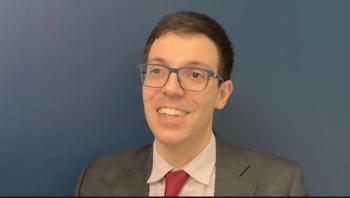
- ONCOLOGY Vol 39, Issue 6
- Volume 39
- Issue 6
- Pages: 238-241
Taletrectinib Increases Already Broad Selection of ROS1+ NSCLC Therapies

Jorge Nieva, MD, discusses how clinical experience has shown that taletrectinib is manageable and can elicit responses in patients with ROS1-positive non–small cell lung cancer.
On June 11, 2025,
Results from the phase 2 TRUST-I (NCT04395677) and TRUST-II (NCT04919811) trials supported taletrectinib’s approval and demonstrated that it either improved upon or was comparable to other agents in the space, such as crizotinib (Xalkori), entrectinib (Rozlytrek), and repotrectinib (Augtyro).2,3
Taletrectinib has several advantages over the other agents, with Nieva specifically highlighting less central nervous system (CNS) toxicity as one of the most prominent. In TRUST-I, the agent showed that patients who were treatment-naive experienced an overall response rate (ORR) of 90% (95% CI, 83%-95%) vs 52% (95% CI, 39%-64%) in those who received prior treatment; in TRUST-II, the ORRs were 85% (95% CI, 73%-93%) and 62% (95% CI, 46%-75%), respectively.
CancerNetwork: What unmet need does the approval of taletrectinib address in ROS1-positive metastatic NSCLC care?
It’s a question of whether it’s a new drug for an unmet need or [if it’s] a drug that has a lot of advantages over the currently available agents. In ROS1-positive lung cancer, we have choices for our patients. In addition to crizotinib, entrectinib, and repotrectinib, taletrectinib is the fourth drug coming to market in this space. It has a number of advantages over the other agents. It has a very different toxicity profile with less CNS toxicity and excellent results from the standpoint of response and progression-free survival [PFS].
What differentiates taletrectinib from other ROS1 inhibitors?
The ROS1 inhibitors all, to some degree, inhibit ROS. The real question that drives their efficacy and toxicity is what impact they have on other tyrosine kinases and similar molecules. Taletrectinib is somewhat unique in that it’s cleaner in terms of its targets. It has less in the way of activity against TREK and a little bit more specificity against ROS1. That’s the thing that sets it apart, from a mechanistic standpoint, from some of the other ROS1 agents that are out there. The results are that you see a little bit less in the way of CNS toxicity, which is characteristic of TREK inhibition.
How did taletrectinib perform in patients with brain metastases?
In all things in oncology, the outcomes are always best when drugs are used in the first line compared with the second line. When looking at the results of the TRUST-I and TRUST-II studies on which taletrectinib is based, we see that patients who are newly diagnosed have a higher response rate—89% compared with 56%—we see a duration of response that’s significantly longer—44 months compared with 17 months—and a PFS which is also much longer—46 months vs 10 months.
We see very high intracranial response rates with taletrectinib, repotrectinib, and entrectinib, and these are all much higher than the drug that sort of started it all, crizotinib. I don’t think there are many people in the US who are still using crizotinib as first-line therapy for ROS1 disease, with the newer generation agents commanding the majority of market share for what most practitioners are doing these days. The good news for patients is that all the newer generation agents have very good CNS penetration, and we can expect that patients who have CNS disease will have reductions in their tumor size in the majority of cases. This means that there will be fewer patients who need to receive CNS radiation, which is something that many people want to try to avoid.
How do you plan to use taletrectinib in your practice?
This is going to be the go-to first-line drug in my practice. I had the opportunity to participate in the clinical trials with this agent. For all oncologists, the more you use a drug, the more you’re comfortable with managing its toxicity and the more comfortable you are with understanding what’s to come for our patient population and counseling them on what they can expect. It’s a drug that I’m very comfortable with, and it is a drug I’ll likely use primarily in the first-line setting.
For patients who were treated with other agents, if they had received entrectinib or some other agent in the past, then they certainly can use this drug in the second line. The good news for patients is that we now have choices, and we have very good drugs for ROS1 disease, including taletrectinib, repotrectinib, and entrectinib, and even crizotinib is a good drug in many parts of the world where they may not have access to some of the newer agents. I’m very happy that we have choices for patients, and I’m very happy that we have such a wide variety of drugs, but we still need to do better, and we need to find better ways of using these agents because they’re still not cures for the majority of patients. While these drugs can be helpful at debulking tumors, we still need to do a lot more work on making this a disease of the past for those patients who have it.
Do you have any specific taletrectinib-related patient cases that stand out?
I had a patient who, when he was first diagnosed, was on crizotinib when the drug first came out. Before it was known that he had ROS1 disease, he had been treated with chemoradiation for locally advanced disease, and then he progressed. We started treating him with ROS1 agents, and he’s been on taletrectinib and [has been] doing well for many years. That’s not out of the realm of what we can expect. When you have a drug with a median [PFS] of almost 4 years, we can expect that most of the patients on this agent will be on it for a very long time, and that’s exciting to see. It’s nice to see [patients with ROS1 disease] doing very well, and having them come back to the clinic year after year with very boring office visits where they come in and say, “Hey, how are you doing? How are my scans? Oh, they’re good. They still look good. I guess I’ll just keep taking my medicine.” Those office visits are quite heartening.
What is the toxicity profile of this agent?
The majority of toxicities for this drug center around the gastrointestinal tract, so nausea and diarrhea are the mainstays of therapy. The good news is, we’re oncologists, and we’re good at treating nausea and diarrhea. We’ve done it for a long time. The [5-HT-receptor] agonists are good choices for the nausea because the [5-HT-receptor] antagonists tend to [cause constipation]…. The combination of both of those features seems to help this patient population. We also have drugs that work on gastrointestinal opiate receptors, like loperamide [Imodium], and those work quite well for diarrhea. From the standpoint of toxicity management, we have a lot of good drugs available for that.
What are some of the next steps necessary for the future of NSCLC care?
We’ve arrived at a very good place from the standpoint of understanding the different biomarkers of lung cancer. The age of treating lung cancer like it’s all one disease is quite over. We now have these biomarker-driven subtypes, such as ROS1-mediated disease, and we can treat them very effectively for long periods of time with tyrosine kinase inhibitors.
The role of consolidation therapy for patients who have good responses is also very important because that extends the duration of time that the patients will stay on active therapy. We need to find ways to achieve disease eradication. Unfortunately, for many of the lung cancers that are not tobacco-related, such as ROS1, ALK, and many of the EGFR cases, there hasn’t been good immunotherapy that’s been able to eradicate the disease, and many of these patients are going to be entirely unresponsive to PD-L1 blockade. We need to figure out a way to fix that and make that happen.
There are a lot of companies out there doing a lot of work on the best ways to make that happen. Whether it’s with bispecific antibodies that target a second receptor or some other strategy that amps up the ability of the immune system to target these cold, immunologically unresponsive tumors, [that] is where the future is going to have to be for us. The immunotherapy revolution in oncology has been a wonderful thing, and the wonderful thing about it is that patients with stage IV disease are now curable where they hadn’t been curable before. For the primary TKI-treated cancers, that promised land hasn’t arrived yet. We still have to figure out a way to make the miracle of immunotherapy work for these patients as well. Learning how to do that and learning what levers we need to pull in lymphocyte biology to make that possible is yet to be seen.
Reference
- FDA approves taletrectinib for ROS1-positive non-small cell lung cancer. News release. FDA. June 11, 2025. Accessed June 23, 2025. https://tinyurl.com/yc4f379m
- Li W, Xiong A, Yang N, et al. Efficacy and safety of taletrectinib in chinese patients with ROS1+ non-small cell lung cancer: the phase II TRUST-I study. J Clin Oncol. 2024;42(22):2660-2670. doi:10.1200/JCO.24.00731
- Nagasaka M, Ohe Y, Zhou C, et al. TRUST-II: a global phase II study of taletrectinib in ROS1-positive non-small-cell lung cancer and other solid tumors. Future Oncology, 19(2), 123–135. doi:10.2217/fon-2022-1059
Articles in this issue
4 months ago
Top Trials From the 2025 ASCO and EHA MeetingsNewsletter
Stay up to date on recent advances in the multidisciplinary approach to cancer.






















































































